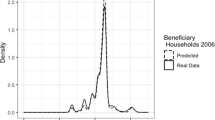
Overview
- Goes beyond the traditional economics-based perspective on Conditional Cash Transfers and offers a policy based perspective
- Addresses issues of political sustainability and policy coordination within the education field
- Builds upon a comparative study of three CCT programs across the Americas
- Includes supplementary material: sn.pub/extras
Access this book
Tax calculation will be finalised at checkout
Other ways to access
About this book
Similar content being viewed by others
Keywords
Table of contents (8 chapters)
-
Front Matter
-
A Best Practice to Reduce Present and Future Poverty
-
Front Matter
-
-
The Realities of CCTs in the Global North and the Global South
-
Front Matter
-
-
What Have We Learned?
-
Front Matter
-
-
Back Matter
Reviews
Authors and Affiliations
About the author
Michelle Morais de Sa e Silva is Wick Cary Assistant Professor of International and Area Studies at the Department of International and Area Studies, University of Oklahoma, USA. Previously, she held the position of Head of Graduate Programs and Professor at Brazil’s National School of Public Administration (Enap). Morais was also Coordinator General for International Cooperation at Brazil’s Ministry of Human Rights (2011-2014). Before that, she had been a UNESCO staff member for six years. Morais has worked in countries like Angola, Colombia, Mozambique and Russia, besides Brazil. Her research agenda has been mostly focused on issues of international cooperation for development, policy diffusion, and international comparative education.
Bibliographic Information
Book Title: Poverty Reduction, Education, and the Global Diffusion of Conditional Cash Transfers
Authors: Michelle Morais de Sá e Silva
DOI: https://doi.org/10.1007/978-3-319-53094-9
Publisher: Palgrave Macmillan Cham
eBook Packages: Education, Education (R0)
Copyright Information: The Editor(s) (if applicable) and The Author(s) 2017
Hardcover ISBN: 978-3-319-53093-2Due: 28 July 2017
Softcover ISBN: 978-3-319-85060-3Published: 01 August 2018
eBook ISBN: 978-3-319-53094-9Published: 19 July 2017
Edition Number: 1
Number of Pages: XXII, 184
Number of Illustrations: 9 illustrations in colour
Topics: International and Comparative Education, Educational Policy and Politics



